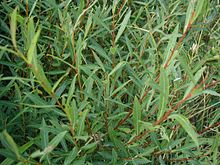Salix purpurea
| Salix purpurea | |
|---|---|

| |
| Catkins | |
| Scientific classification | |
| Kingdom: | Plantae |
| Clade: | Tracheophytes |
| Clade: | Angiosperms |
| Clade: | Eudicots |
| Clade: | Rosids |
| Order: | Malpighiales |
| Family: | Salicaceae |
| Genus: | Salix |
| Species: | S. purpurea
|
| Binomial name | |
| Salix purpurea | |
Salix purpurea (purple willow[1] purpleosier willow[2] or purple osier) is a species of willow native to most of Europe and western Asia north to the British Isles, Poland, and the Baltic States.[3][4][5]

It is a deciduous shrub growing to 1–3 m (rarely to 5 m) tall, with purple-brown to yellow-brown shoots, turning pale grey on old stems. The leaves are 2–8 cm (rarely to 12 cm) long and 0.3–1 cm (rarely 2 cm) wide; they are dark green above, glaucous green below, and unusually for a willow, are often arranged in opposite pairs rather than alternate. The flowers are small catkins 1.5-4.5 cm long, produced in early spring; they are often purple or red in colour, whence the name of the species (other willows mostly have whitish, yellow or green catkins).
It is replaced further east in Asia by the closely related species Salix sinopurpurea (syn. S. purpurea var. longipetiolatea).[6]
The weeping cultivar ‘Pendula‘ has gained the Royal Horticultural Society’s Award of Garden Merit.[7][8] As with several other willows, the shoots, called withies, are often used in basketry. The wood is used in making cricket bats.[4][5]
References
- ^ "BSBI List 2007". Botanical Society of Britain and Ireland. Archived from the original (xls) on 2014-10-23. Retrieved 2014-10-17.
- ^ USDA, NRCS (n.d.). "Salix purpurea". The PLANTS Database (plants.usda.gov). Greensboro, North Carolina: National Plant Data Team. Retrieved 27 October 2015.
- ^ Flora Europaea: Salix purpurea
- ^ a b Meikle, R. D. (1984). Willows and Poplars of Great Britain and Ireland. BSBI Handbook No. 4. ISBN 0-901158-07-0.
- ^ a b Rushforth, K. (1999). Trees of Britain and Europe. Collins ISBN 0-00-220013-9.
- ^ Flora of China: Salix sinopurpurea
- ^ "RHS Plantfinder - Salix purpurea 'Pendula'". Retrieved 12 October 2018.
- ^ "AGM Plants - Ornamental" (PDF). Royal Horticultural Society. July 2017. p. 93. Retrieved 12 October 2018.
![]() Media related to Salix purpurea at Wikimedia Commons
Media related to Salix purpurea at Wikimedia Commons
